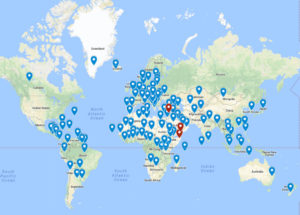Visiting the Torture Museum: Barbarism Then and Now
Someday, at an official U.S. torture museum, our children may wonder how we ever adopted the worst traditions of terror in the Age of Barbarism Lite. gammaman (CC BY 2.0)
gammaman (CC BY 2.0)
By Karen J. Greenberg, TomDispatchThis piece first appeared at TomDispatch. Read Tom Engelhardt’s introduction here.
Sometimes a little stroll through history can have its uses. Take, as an example, the continuing debate over torture in post-9/11 America. Last week, Stephen Bradbury, the head of the Justice Department’s Office of Legal Counsel, testified before the House Judiciary Committee about waterboarding. In defending its use, Bradbury took a deep dive into the past. He claimed that the CIA’s waterboarding of at least three of its prisoners bore “no resemblance” to what torturers in the Spanish Inquisition had done when they used what was then called “the Water Torture.”
As part of his defense of the techniques used by the Bush administration to gain information, Bradbury went out of his way to play the historian, claiming that the water torture of yore differed from today’s American-style version in crucial ways. The waterboarding employed by interrogators during the infamous Spanish Inquisition, he insisted, “involved the forced consumption of a mass amount of water.” This led, he claimed, to the “lungs filling with water” to the point of “agony and death.” The CIA, on the other hand, employed “strict time limits,” “safeguards,” and “restrictions,” making it a far more controlled technique. As he put it: “[S]omething can be quite distressing or uncomfortable, even frightening, [but] if it doesn’t involve severe physical pain, and it doesn’t last very long, it may not constitute severe physical suffering” — and so would not qualify as torture. Bradbury summed up his historical case this way, “There’s been a lot of discussion in the public about historical uses of waterboarding,” but the “only thing in common is the use of water.”
To remind readers, Bradbury is the government lawyer who, in 2005, drafted two secret memos authorizing the use of freezing temperatures, and waterboarding in CIA attempts to break terrorism detainees. Nor is Bradbury the only one with the urge to distinguish any current American proclivity towards torture from the barbaric procedures used until the Enlightenment set in. As Senator Joseph Lieberman commented last week, citing another medieval torture technique, waterboarding “is not like putting burning coals on people’s bodies. The person is in no real danger. The impact is psychological.” Waterboarding isn’t torture, both men claimed, because it leaves no “permanent damage.”
Visiting the Water Table
It’s here that our stroll down history’s narrow, medieval lanes comes in. Anyone curious to test Bradbury’s historical accuracy should consider a visit to one of the dozens of torture museums that dot Europe’s landscape. Why not, for instance, the bluntly named Torture Museum in Prague, the capital of the Czech Republic. Unlike other European memorials to torture, such as the Clink Prison in London and the torture museums in Florence and San Gimigniano, this modest two-story building in a former private home in Prague’s historic Old Town is a relative newcomer to the continent’s penchant for recording its past mistakes.
Upon entering one of a series of gloomy, cave-like rooms, filled with the implements of the dismal craft that had its heyday from the fifteenth to the eighteenth century, you would notice a range of mechanical devices and iron tools (also illustrated in drawings galore), all once meant to pierce, prod, or otherwise drive some poor heretic into the agony of confession. Often in those years before video cameras were available, all this was done in public sight.
And then, as you wound your way through the exhibit, you would come upon one of its centerpiece displays — the “water torture table” to which Bradbury alludes. After you’d checked out the period drawings of prisoners being tied to the edges of the flat tabletop or read about the interrogation method in which the water-filled abdomen was struck repeatedly with heavy blows, you might stop for a moment to consider the more detailed explanatory text nearby.
It would inform you that, over the course of these centuries, several water torture techniques were developed, one of which involved “inserting a cloth tube into the mouth of the victim [and] forcing it as deep as possible into his throat. The tube was then filled slowly with water, swelling up and choking the victim.” This is, in fact, an almost exact description of what has been described as CIA-style waterboarding. Former interrogation expert Malcolm Nance, once an instructor for the U.S. military’s SERE (Survival, Evasion, Resistance, and Escape) training program — said to have been the template for some of the interrogation techniques the Bush administration developed — himself experienced waterboarding. He has described the process this way:
“Unless you have been strapped down to the board, have endured the agonizing feeling of the water overpowering your gag reflex, and then feel your throat open and allow pint after pint of water to involuntarily fill your lungs, you will not know the meaning of the word.
“Waterboarding is a controlled drowning that, in the American model, occurs under the watch of a doctor, a psychologist, an interrogator and a trained strap-in/strap-out team. It does not simulate drowning, as the lungs are actually filling with water. There is no way to simulate that. The victim is drowning. How much the victim is to drown depends on the desired result (in the form of answers to questions shouted into the victim’s face) and the obstinacy of the subject.”
The similarity in methods across a torture gulf of at least four centuries would have been but the first of many striking lessons for our modern moment from a tour of this museum, only steps from the famed Charles Bridge with its own medieval and religious statues, a museum modest in everything but its subject matter. Perhaps the eeriest lesson would be just how many of the torture techniques illustrated in these rooms are still painfully recognizable, are, in fact but minor variations on those practiced today in America’s name.
Take, for example, those etchings of the strappado or “jerking” in which the arms were pulled up behind the prisoner in what would now be called a “stress position” before he would be “jerked” or dropped painfully. The weights and leather ties on display are perhaps a reminder that a version of the strappado is perhaps the most common form of torture reportedly used throughout America’s offshore prison systems today. It is called “short shackling.”
And don’t forget the Vigil or Cradle of Judas, which today we far more mundanely term “sleep deprivation.” Or what about the medieval use of cold water sprinkled onto naked bodies (another kind of water torture), today mimicked with what official documents call “exposure to freezing temperatures”? Of course, with those infamous photos from Iraq’s Abu Ghraib prison in mind, you would have no trouble recognizing the persistent themes of nakedness and sexual humiliation endemic to what no one back in the less civilized days of the Inquisition hesitated to label “torture.”
Torture Lite
As you wandered through the Prague Torture Museum, noting all the practices other than waterboarding that have their modern American equivalents, you shouldn’t skip past the medieval forms of torture the United States doesn’t practice. Scattered through these precincts are terrifying mechanical devices and tools that once led to permanent physical damage and often to the death of those being questioned. Take the Virgin of Nuremberg, a full-body casket studded with spikes meant to slowly pierce any living being closed inside and sure to cause a long, agonizing death.
Then, there’s the Bock, often called the Witch’s Billy Goat, a wood pyramid designed to pierce the genitals, and that torture shown in classic Hollywood medieval costume dramas, the Rack, in which the human body was literally stretched beyond the tearing point, or the Garrote, an instrument whose sole task was to crush the head.
Had Stephen Bradbury come along with you, eager to discover the differences between pre-Enlightenment torture and today’s “enhanced interrogation” methods, he might feel satisfied indeed as he passed through this part of the exhibit — if, that is, he avoided the accompanying texts that sit on small easels near these horrifying arrays of instruments. For on them, you and he would find the theory that lay behind the practices of those torturers from a barbaric past, and he would discover that those torturers of old, like his colleagues in the Bush administration, distinguished between torture and Torture Lite. The former was indeed meant to result in permanent damage or simply death. The latter was consciously meant to cause “mere” suffering, however protracted.
Reading these texts, Bradbury might find himself uncomfortably at home. After all, his Justice Department has followed similar reasoning, although, unlike medieval torturers, its practitioners have used it as the basis for distinguishing between torture and what they like to describe as “enhanced interrogation techniques.” They have, in other words, declared part of the Spanish Inquisition’s torture techniques too lenient to qualify as torture. This is perhaps their unique achievement.
Medieval torturers, of course, hadn’t had the benefit of the Enlightenment and modern American civilization when they failed to make this fundamental distinction. They did not understand that the infliction of “mere suffering” did not qualify as torture.
If Bradbury were being honest with himself, however, he would certainly recognize a parallel between the medieval distinctions and those made by his predecessor as head of the Office of Legal Counsel, John Yoo. In his infamous “Torture Memo” of August 2002, Yoo parsed the definition of torture this way: “[Torture] must be of an intensity akin to that which accompanies serious physical injury such as death or organ failure Because the acts inflicting torture are extreme, there is [a] significant range of acts that though they might constitute cruel, inhuman, or degrading treatment or punishment fail to rise to the level of torture.”
In terms of torture as it was understood from medieval times until the Enlightenment, what American interrogators have inflicted on terror suspects in secret prisons around the world has amounted “only” to Torture Lite, now redefined as “mere suffering” and so not really torture at all. As Bradbury reminded congresspeople just the other day, what we do is, by definition, not torture. Following Yoo’s and Bradbury’s lead, the President, Vice President, two Attorney Generals, and the Secretary of State have joined in the same chorus, repeatedly insisting that “we do not torture.” And in John Yoo’s terms, echoing pre-Enlightenment understandings, we don’t.
Now, if Bradbury were to stop off by that Water Torture table on his way out of the museum and then opened his catalogue of the show, he might be intrigued to discover as succinct a legitimization of his form of torture as any he offered Congress. The catalogue follows a passage noting that the medieval water torture “in all of its variations, was considered ‘light'” with this: “and any eventual confession obtained through this technique was considered by the courts to be ‘spontaneous’ and obtained without the application of torture.”
If this isn’t a moving example of the brotherhood of torturers across the centuries, what is? After all, just as in the distant past, there has, in recent years, been purpose behind the seeming madness with which the Bush administration embraced torture and then repeatedly insisted on calling it not-torture. The purpose centuries ago was to have any confessions admissible in court — and this, certainly, was what Yoo and his colleagues must have been hoping for all along. In the specific cases of the three detainees whom top administration officials have recently admitted were waterboarded — Khalid Sheikh Mohammed, Ibn al Shayk al-Libbi, and Abu Zubaydah — their confessions, obtained by a range of “enhanced interrogation techniques,” have repeatedly been called trustworthy, valuable, and conclusive as to guilt by administration spokespeople.
Someday, Americans will have to reckon with this period of time — and with a group of leaders who were more comfortable with definitions out of the darker ages than ones out of the Enlightenment era. This administration’s bold flirtation with torture, medieval-style, has led us into sorry company, whether in the past or the present. Its top officials told the world they would do “what it takes” in their war on terror and in the Middle East, with or without allies. They then chose to leave the family of nations and take up kinship in the family of torturers.
Someday, our children may travel to Washington and somewhere near the Smithsonian and the Holocaust Museum, perhaps they, like the Czechs and other Europeans, will be able to visit their own official torture museum. There, a step from the Potomac River, they will be able to view strange instruments for inflicting pain and perhaps even watch horrifying videos of torture happening. And they may wonder how we ever faltered so miserably when it came to a war that was supposed to be on terror, but ended up adopting the worst traditions of terror in the Age of Barbarism Lite.
Karen J. Greenberg is the Director of the Center on National Security at Fordham Law. A TomDispatch regular, she is the editor of The Torture Debate in America and co-editor of The Torture Papers: The Road to Abu Ghraib. She is the author of The Least Worst Place: Guantanamo’s First 100 Days. Kevin Garnett, research fellow at the Center on National Security, contributed research to this article.
Follow TomDispatch on Twitter and join us on Facebook. Check out the newest Dispatch Book, Rebecca Solnit’s Men Explain Things to Me, and Tom Engelhardt’s latest book, Shadow Government: Surveillance, Secret Wars, and a Global Security State in a Single-Superpower World.
Copyright 2015 Karen J. Greenberg
Your support matters…Independent journalism is under threat and overshadowed by heavily funded mainstream media.
You can help level the playing field. Become a member.
Your tax-deductible contribution keeps us digging beneath the headlines to give you thought-provoking, investigative reporting and analysis that unearths what's really happening- without compromise.
Give today to support our courageous, independent journalists.






You need to be a supporter to comment.
There are currently no responses to this article.
Be the first to respond.